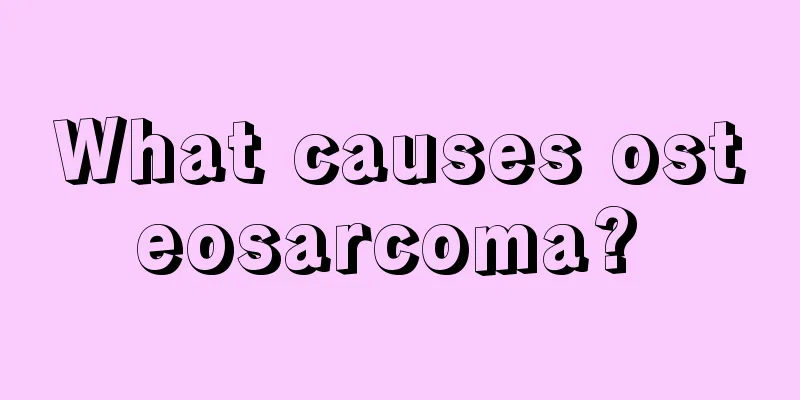What causes osteosarcoma?

|
Osteosarcoma is the most common type of malignant bone tumor. It develops from the mesenchymal cell line. The rapid growth of the tumor is due to the direct or indirect formation of tumor bone-like tissue and bone tissue through the cartilage stage. Under the influence of external factors (such as viruses), the weight-bearing bones of the lower limbs cause cell mutations, which may be related to the formation of osteosarcoma. The typical osteosarcoma originates from the bone. Another completely different type is the osteosarcoma that is parallel to the bone cortex and originates from the periosteum and nearby connective tissue. The latter is less common and has a slightly better prognosis. 1. Causes of disease Modern medicine has not yet fully understood the cause of this disease. Some people point out that radioactive isotope radium and traumatic stimulation are inducing factors. Lesions occurring in long bones are mostly located in the epiphysis, and a few in the middle of the shaft. The tumor rapidly develops along the medullary cavity. On the one hand, it spreads to the epiphyseal end. On the other hand, the tumor occasionally spreads to the shaft. The tumor also rapidly develops outward, invading the Hasserian system in the cortical bone and causing vascular nutritional disorders. The cortical bone is then destroyed, and the tumor quickly reaches under the periosteum and invades the adjacent muscle tissue outward. In addition, it is related to genetics, exposure to radioactive substances, viral infection, etc. It can also be secondary to osteitis deformans and fibrous dysplasia of bone. Some cases are caused by the malignant transformation of other benign tumors. 2. Pathogenesis The pathogenesis of this disease is still not very clear. Its histological feature is that the proliferating spindle-shaped tumor cells directly produce osteoid matrix or immature bone, but its hair type is different and its histological characteristics are also different, which have been described in this article. Osteosarcoma originates from primitive progenitor cells, which have multipotential characteristics and can differentiate into bone, cartilage and fiber. Therefore, in addition to malignant osteoblasts, osteosarcoma also has chondroblasts and fibroblasts. According to the amount of these three cell components, central osteosarcoma can be divided into osteoblast type (osteoblastic type), chondroblast type (cartilaginous type) and fibroblast type (fibroblastic type). 1. The tumor seen with the naked eye occurs in the medullary cavity and expands, destroys and penetrates the cortical bone into the soft tissue. The shape of the tumor varies depending on the location of the tumor. The color and texture of the tumor section may vary due to different cellular components, including grayish white, soft, fish-like, bluish white, brittle, cartilage-like, grayish white, tough, rubber-like and ivory-like tumor bones. The necrotic and hemorrhagic areas are grayish yellow and reddish brown distributed between the tumors. The cortical bone that is penetrated by the tumor on one side does not expand, and the periosteum is lifted up to reveal a triangular periosteal reaction. 2. Light microscopy shows that the tumor cells are spindle-shaped, polygonal, or round, with obvious intercellular changes. The cells are of different sizes and shapes, with large nuclei and obvious nucleoli. Pathological nuclear division is common. In well-differentiated areas, tumor cells can be seen directly forming neoplastic bone and bone-like tissue, which are pink-stained homogeneous cords and small flakes. The more mature the tumor is, the more bone and bone-like tissue it forms. Osteoclast-type giant cells and areas of hemorrhage and necrosis can sometimes be seen. (1) Osteoblastic type: It is mainly composed of malignant osteoblasts with obvious atypia, forming more tumor bone and bone-like tissue. The degree of differentiation of cells varies. Some are more mature, with no obvious atypia, forming more tumor bone, while others are poorly differentiated, with very obvious tumor cell atypia, easy to see nuclear division, and forming less tumor bone and bone-like tissue. (2) Chondroblastic type: In addition to osteoblasts, half of the tumor tissue is chondrosarcoma structure. At the same time, tumor cells can be seen directly forming neoplastic bone and bone-like tissue. (3) Fibroblastic type: The tumor cells are spindle-shaped and arranged in a spoke-like pattern. Tumor cells can be seen directly forming neoplastic bone and bone-like tissue between them. The above three types often exist in mixture, and are currently called traditional types. 3. Electron microscopy shows that the tumor is composed of five types of cells, the most basic of which is malignant osteoblasts, followed by chondroblasts, fibroblasts, myofibroblasts and undifferentiated cells. In addition to the five types of cells, there is also tumorous bone-like tissue. (1) Malignant osteoblasts: The nucleus is irregularly round or oval, the nuclear membrane is serrated, the nuclear chromatin is slightly condensed, the nucleolus is obvious, the cell is filled with rough endoplasmic reticulum, there are few mitochondria, a small amount of cristae, the Golgi complex is relatively developed, there are protrusions on the cell surface, and there are no cell connectors between cells. (2) Malignant chondrocytes: The nucleus has obvious metaplasia, irregular microvilli on the surface, a clear zone around the cell, well-developed rough endoplasmic reticulum in the cytoplasm, oval mitochondria with obvious cristae, well-developed Golgi complex, vacuoles in the cytoplasm, and occasional lysosomes. (3) Malignant fibroblasts: The cells are spindle-shaped, with irregular cytoplasm, long oval nuclei, depressions on the nuclear membrane surface, marginal chromatin, abundant rough endoplasmic reticulum in the cytoplasm, and a moderate amount of mitochondria. (4) Undifferentiated cells: These cells have a relatively high nuclear-to-cytoplasmic ratio and few organelles, and are the main cellular components of osteosarcoma. (5) Myofibroblasts: Myofibroblasts can be seen in most osteosarcomas. They are spindle-shaped, have abundant cytoplasmic microfilaments, and have abundant rough endoplasmic reticulum in the cytoplasm. The tumorous bone-like tissue is composed of collagen fibers and proteoglycans, and has different manifestations in different areas of the tumor. In the osteogenic area, the bone-like matrix is dominant. In the chondroblast area, collagen fibers are formed and there are a large number of proteoglycans. In this fibroblast area, there is no obvious osteogenesis of the fibrocytes. |
<<: What are the common symptoms of bladder cancer?
>>: What is the cause of osteosarcoma?
Recommend
Cost of pancreatic cancer surgery
Patients with pancreatic cancer, in addition to w...
The efficacy and function of pepper wood
The effects and functions of pepper wood can reli...
What are the effects of lysine hydrochloride
Lysine hydrochloride is an element that can suppl...
How can black neck be cured
Usually, everyone pays attention to the care of f...
Bypass 7 annoying health problems that trap you in life and easily break them
Find out what little troublemakers are lurking in...
How long does it take for a pregnant woman to recover from lymphoma
How long can a pregnant woman with lymphoma live?...
Can long-term constipation lead to cervical cancer? Is it true that eating mushrooms can prevent cervical cancer?
One in six women suffers from cervical cancer, wh...
Why does pituitary tumor recur?
Why do pituitary tumors recur? Pituitary tumors a...
How to remove oil stains from the outside of a non-stick pan?
Non-stick pans are a very famous type of modern c...
Is laser lithotripsy harmful to the kidneys?
Many people have heard that laser can break up st...
When is the best time to run?
Nowadays, many people pay more and more attention...
How to deal with pimples after squeezing them
Many people have a very bad habit after they get ...
What to do if toothache medicine doesn't work
Toothache can be said to be a very common discomf...
Why does my wrist hurt after a fall?
Wrestling is a form of entertainment that origina...
Which method is the best for treating small liver cancer? Teach you how to choose the treatment method for small liver cancer
Reasonable selection of treatment methods for sma...









